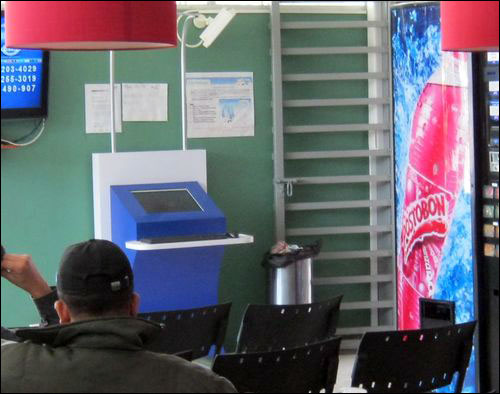Sep 29, 2011One year after installing a radio frequency identification system to better manage the operations of logistics providers at its warehouse, Kimberly-Clark's plant in Tocancipa, Colombia, finds that it has gained efficiency, as well as visibility into when truck-loading delays occur. The factory is employing the technology to manage the shipment of goods by the transport companies, which are responsible for picking up and delivering products to customers. K-C Colombia shares that data with those transport businesses, thereby providing them with improved information regarding the status of the loads that their drivers pick up and deliver. In this way, the logistics providers benefit by being forewarned of any delays, and can thus schedule their trucks accordingly.
The Tocancipa plant provides products that leave the facility at a rate of approximately 2,000 to 2,500 truckloads monthly, and are transported throughout Colombia. "The problem we had," says Ana Maria Gonzalez, who works for Kimberly-Clark Colombia as an analyst of logistics development, "was that the logistics representatives didn't have a clear visual of which trucks were available to be assigned to a shipment, or which trucks were already loading products." Once a truck departed for the K-C plant's warehouse, the transport companies had no knowledge of how long the trucks had remained at that warehouse, or when there was a delay. Consequently, they experienced numerous setbacks in their own deliveries to customers.

To improve its control of and visibility into this logistics process, the factory deployed the RFID Tracking System software solution from AutoID Systems, based in Bogotá. The plant also installed ThingMagic readers at the facility gate, as well as in the driver waiting area, and began issuing driver ID cards containing EPC Gen 2 passive ultrahigh-frequency (UHF) inlays.
The ID cards are created by means of a Zebra Technologies RFID card printer-encoder. Upon being entered into the system, each driver provides his name and company name, which are stored in the standalone AutoID Systems software, residing on K-C's back-end server. Other information is also stored on that server, such as a particular truck's size, which helps the company track how long the loading process is expected to last. The unique ID number encoded to the card's RFID inlay is then linked to that driver's data. To date, Kimberly-Clark has provided the RFID-enabled ID cards to approximately 300 drivers.
Information regarding the driver, as well as his arrival time, the vehicle that person is driving, and the transport company for which he works, are displayed on a Web site accessible only by the logistics company and Kimberly-Clark's staff. The logistic providers use the Web site to learn which vehicles are available for loading and distribution, which have arrived at the factory, which docks are presently available, and details about the specific orders to be loaded onto the vehicles.
For drivers who are not among the 300 and who regularly transport K-C products, the company provides generic ID cards. When such a driver arrives at the plant, a guard at the gate invites that person to fill out paperwork and enroll in the system. The driver also learns about the plant's security regulations and logistics processes. Kimberly-Clark's staff then hands that individual a generic card containing a unique ID number linked, for the duration of that visit, with his personal data, such as that person's name, and that of the logistics provider. The temporary data for that ID is also displayed on the warehouse monitor.
After checking in at the gate, the driver pulls into a dock, leaves the truck and is directed to a waiting room area within the warehouse. As that individual enters the room, a ThingMagic reader captures the ID number encoded to his ID card, and forwards that information to the AutoID Systems software. The software stores the time that the driver arrived, linked to the length of time expected for the loading of that specific truck. If the loading process takes longer than predicted, the monitor displays information regarding that driver and truck in red, thereby indicating an overload time.
Once the truck has been fully loaded, the driver leaves the waiting area, and the reader ceases to receive that person's card ID number, at which point the software determines that the truck has now been loaded and will soon depart the facility. While passing through the gate in order to exit the grounds, the driver steps out of the truck one final time to hand over paperwork, at which point the ID card is read once more, indicating the vehicle's departure.
In addition, Kimberly-Clark also utilizes the data to perform business analytics. The company can not only determine the efficiency of the loading process at any given day or time, but also track the drivers and ascertain how often they arrive on time or late. This information, Gonzalez explains, allows the firm to work with the transport company to improve punctuality—which, thanks to the RFID system, "has greatly improved for the benefit of K-C and the transport company."
Because each driver's arrival and loading data is managed automatically, Gonzalez notes, it is impossible for staff members to show preference by serving one driver ahead of another. What's more, she says, "drivers don't feel anxious waiting, because they know they have been already registered automatically. In fact, they can see the registration list in the online monitor."
Gonzalez adds, "We want all drivers to feel proud to work for a company such as Kimberly. This is why we are always looking for systems, software, etc., with cutting-edge technology in order to provide our suppliers with the best assistance and speed in the processes, as well as a decent place to rest while loading and unloading."
Kimberly-Clark intends to install a similar system at its other Colombian plants in early 2012.


